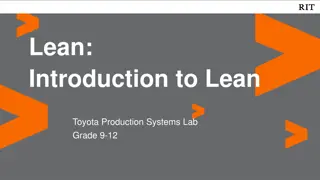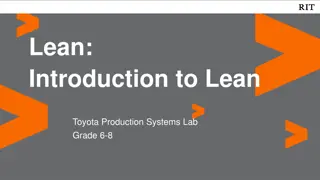Lean Six Sigma in Human Resources: A Comprehensive Overview
Explore the history and evolution of Lean Six Sigma, its methodology, success factors, and application to HR. Gain insights into real-world examples and a case study from New York ISO, presented by David Duda with over 12 years of experience in Lean Six Sigma. Discover how Lean Six Sigma enhances quality through waste removal and process variation reduction, expanding beyond production environments to transactional applications across various industries.
Download Presentation

Please find below an Image/Link to download the presentation.
The content on the website is provided AS IS for your information and personal use only. It may not be sold, licensed, or shared on other websites without obtaining consent from the author. Download presentation by click this link. If you encounter any issues during the download, it is possible that the publisher has removed the file from their server.
E N D
Presentation Transcript
Introduction to Lean Six Sigma A Human Resources Perspective
Agenda Short Biography History of Lean Six Sigma (LSS) LSS Methodology Success Factors Application to HR Examples of project ideas New York ISO case study
About the Presenter David Duda Over twelve years of LSS experience Delta Airlines, Inc. 1998-2008 Production based application of LSS New York Independent System Operator 2008--Present Service/transactional based application of LSS Certified Six Sigma Black Belt Contact Info: pdduda@gmail.com
The History of Lean Six Sigma A New Approach to Quality
History of Lean Six Sigma What is in a name? Lean -- Focuses on removing waste (muda) from processes Six Sigma Focuses on understanding and reducing variation in processes Lean Six Sigma (LSS) Combines both approaches What is the Concept behind LSS? As wasteful activities are removed overall process variation is reduced Lean Six Sigma is one of many methodologies developed through the Quality Revolution
HistoryEvolution of Quality Craft Production Each item is unique Individual parts made to fit Quality through craftsmanship Mass Production High volume Interchangeable parts Quality through inspection Better Production Understanding of process variation Quality through process
Evolution of Quality--Timeline 1798 1920s 1950 1960 1980 Statistical Process Control Toyoda Production System Reconstruction of Japan Interchangeable Parts Six Sigma Eli Whitney Walter Shewhart Deming & Juran Eiji Toyoda Motorola
Expanding Application of LSS Initially applied in production environments Manufacturing Supply Chain Maintenance Repair and Overhaul (MRO) Rapidly grew into transactional applications Financial Institutions Insurers Continued to expand to services Hospitals and Health Care
A Couple of Questions What does Six Sigma mean? A process that has a six sigma level of quality experiences only three defects per one million opportunities. Is it Important to have a six sigma level of quality? It depends on the customers perception of quality. If you are landing airplanes, it is critical to obtain at least a six sigma level of quality. If you are manufacturing coffee stirrers, lower levels of quality may be completely acceptable. 1. a. 2. a) Sigma Level 6 Sigma 5 Sigma 4 Sigma 3 Sigma 2 Sigma 1 Sigma DPMO 3.4 233 6210 66,810 308,770 697,672
How Good is Good Enough? Sigma Level Improvements 3 Sigma 3 Sigma 4 Sigma 4 Sigma 93.3193% Accurate 93.3193% Accurate 133,600 lost letters per hour 33,400 33,400 incorrect surgical operations per week 13 13 short or long landings at most major airports each day 1,336,000 1,336,000 wrong prescriptions each year 99.379% Accurate 99.379% Accurate 133,600 12,420 12,420 lost letters per hour 3,100 3,100 incorrect surgical operations per week 1 1 short or long landing at most major airports each day 124,200 124,200 wrong prescriptions each year 5 Sigma 5 Sigma 6 Sigma 6 Sigma 99.9767% Accurate 99.9767% Accurate 466 lost letters per hour 117 117 incorrect surgical operations per week 17 17 short or long landings every year at most major airports 4,660 4,660 wrong prescriptions each year 99.99966% Accurate 99.99966% Accurate 6.8 lost letters per hour 1.7 1.7 incorrect surgical operations per week 1 1 short or long landing every 5 years at most major airports 68 68 wrong prescriptions each year 466 6.8 11
Lean Six Sigma Methodology What is Lean Six Sigma?
LSS Methodology DMAIC Process Key Concepts Understanding Variation Voice of the Customer Voice of the Process LSS Organizational Roles Champion Master Black Belt Black Belt Green Belt Yellow Belt
DMAIC Process What is the problem? What is the goal? Define What is the current performance? What is the defect rate? Measure What are the sources of process variation? What are the root causes of defects? Analyze How do we change the process? How do we verify our changes will improve the process? Improve Are the improvements to the process consistent over time? How do we maintain the improvement into the future? Control
Key Concepts of LSS Understanding of Variation Two types of variation Controlled variation (Common Causes) Uncontrolled variation (Assignable/Special Causes) Improvement strategy based on type of variation Controlled variation = Change the process Uncontrolled variation = Deal with the special events Voice of the Customer (VOC) How does the customer describe quality What is the customers tolerance for defects VOC is often expressed as specification limits Goals should align with the voice of the customer
Key Concepts of LSS Voice of the Process (VOP) What is the current process capability How much variation is in the process How many defects does it produce What is the process average What process inputs are important to final quality Conceptual Summary of Lean Six Sigma Y= (x) The Output (Y) is a function ( ) of the inputs (x)
LSS Organizational Roles Champions Master Black Belts Black Belts Green Belts Yellow Belts
Lean Six Sigma Success Factors What are the building blocks for successful LSS programs?
Considerations for LSS Success Organizational Factors Commitment of Senior Management Clear organizational vision and goals Effective LSS training strategy LSS Team Factors Flexibility Practicality Focus on Customers (Internal and external) Strengths of LSS Methodology Data Based Scalable Structured
Considerations for LSS Success LSS Challenges It is not a quick win approach to continuous improvement It requires an investment It requires a degree of organizational humility
Applying LSS in Human Resources Can I apply LSS to my processes?
Questions for Consideration You have mentioned that LSS is an organizational approach. Can I learn LSS concepts and apply them to my area of expertise? What are the challenges faced when trying to apply LSS to HR processes when the larger organization hasn t embraced the methodology? What are the unique challenges for HR in the application of LSS? What types of process are idea for LSS application? 1. 2. 3. 4.
Effective LSS Application In HR A Case Study: The New York Independent Operator (NYISO)
NYISO Success Factors Well-defined corporate mission and goals Executive commitment to LSS Established infrastructure to support LSS Systematic approach to LSS training Focus on core processes (affecting multiple value streams) Supportive corporate goal structure
Background -- The Roles of the NYISO Reliable operation of the bulk electricity grid Managing the flow of power nearly 11,000 circuit-miles of transmission lines from more than 300 generating units Administration of open and competitive wholesale electricity markets Bringing together buyers and sellers of energy and related products and services Planning for New York s energy future Assessing needs over a 10-year horizon and evaluating the feasibility of projects proposed to meet those needs Advancing the technological infrastructure of the electric system Developing and deploying information technology and tools to make the grid smarter
Case Study Project Title: Reduce Cycle Time to Hire for Open Positions Problem Project baseline data reviewed from November of 05 to November of 06 Average cycle time to hire was 70 days (Median = 43 days) Standard deviation was 70 days 57 percent of positions filled within 60 days Goal Fill open positions in 60 days or less 90 percent of the time Result 87 percent of positions were being filled in 60 days or less (2007)
Overview of Improvements Defined and communicated HR Hiring Process / Roles to NYISO Management Implemented Kick-Off Meetings for all Openings: Review/Define Job Specs and Posting information Discuss salary range and position level Discuss Pre-Screening questions and timing Discuss Recruiting strategy Review Hiring Process and HR/Hiring Manager Roles Standardized Pre-Screening process and questions Developed standard interview format, questions, evaluation Created dashboards for HR management and Senior Team reporting
Controls Overview Process Step Strategy Session Control Activity Requisition signed by HR and Hiring Manager before recruiting begins Legal Review for Fair Labor Standards Act ramifications Hiring Manager review / signoff before posting Generalists secure approval signoff from Management and HR Job Description Changes Job Posting Preparation Offer Preparation
Appendix Supplemental Material
Improvement Process Road Map Define Measure Analyze Improve Control Define Activity Identify Problem Complete Charter Develop SIPOC Map Finalize Project Focus Measure Activity Develop Operational Definitions Develop Data Collection Plan Collect Baseline Data Determine Process Performance/Capability Validate Business Opportunity Review EBPM&C process maps to create As-Is Process Map Analyze Activity Propose Critical X s Prioritize Critical X s Conduct Root Cause Analysis on Critical X s Validate Critical X s Prioritize Root Causes Improve Activity Develop Potential Solutions Develop Evaluation Criteria & Select Best Solutions Work with EBPM&C to create Develop To-Be Process Map(s) Develop High-Level Implementation Plan Develop Pilot Plan & Pilot Solution Control Activity Develop SOP s, Training Plan & Process Control System Implement Process Changes and Controls Monitor & Stabilize Process Transition Project to Process Owner Tools Charter Form Multi-Generational Plan Stakeholder Analysis Communication Plan SIPOC Map Voice of Customer (VOC) Defect definition Goal definition Tools Pareto Charts Fishbone Diagrams Brainstorming 5 Why s Non Value-Added Analysis Tools Control Charts Standard Operating Procedures (SOP s) Communication Plan Implementation Plan Training Plan Process Control Plans Tools Operational Definitions Data Collection Plan Graphical Analysis Pareto Chart Histogram Box Plot Run Chart Detailed As-Is Process Maps Tools Brainstorming Solution Selection Matrix To-Be Process Maps Piloting and Simulation From: NYISO Green Belt Training Module Intro to LSS
Lower Spec Limit Upper Spec Limit 68.26 % -3 -2 -1 1 2 3 Voice Of The Process 95.44 % -3 -2 -1 1 2 3 99.73 % Why 6 Sigma? -3 -2 -1 1 2 3 6s Units from the mean to nearest spec. limit 99.99999975 Voice Of The Customer
Sources of Information The New Economics: W. Edwards Deming Lean Thinking: James P. Womack and Daniel T. Jones Understanding Statistical Process Control: Donald J. Wheeler and David S. Chambers Lean Production Simplified: Pascal Dennis Knowledge gained producing training material and supporting LSS training for the following organizations: Delta Air Lines, Inc. New York Independent System Operator
Helpful Links General Info: Six Sigma Website: http://www.isixsigma.com Organizations that provide Six Sigma Training: ASQ: http://asq.org/certification/index.html BMGI: http://www.bmgi.com/
Disclaimer This presentation was not prepared by, with, or for the New York Independent System Operator, Inc., and any opinions expressed or conclusions reached herein are not the opinions or conclusions of the New York Independent System Operator, Inc.























